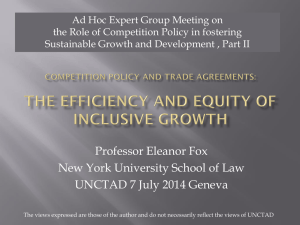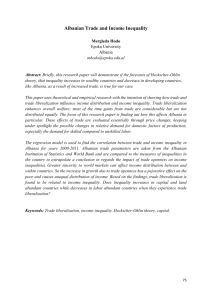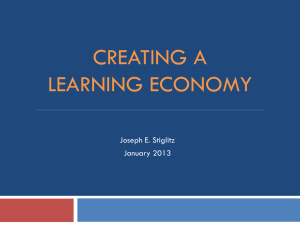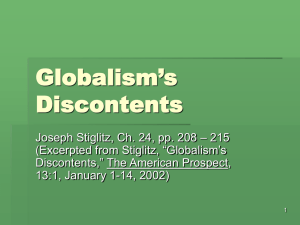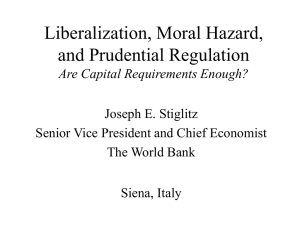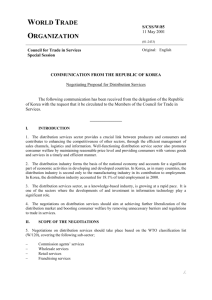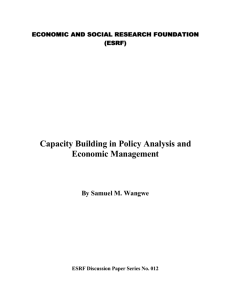Gradualism, the Bicycle Theory, and Perpetual Trade Liberalization1
advertisement
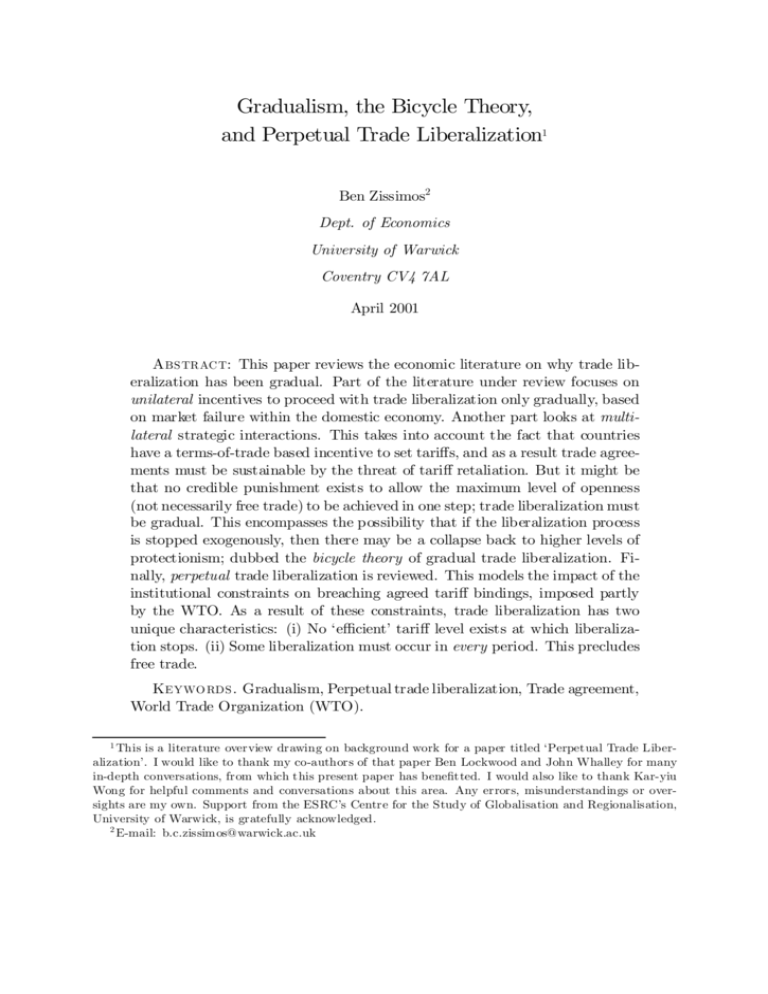
Gradualism, the Bicycle Theory, and Perpetual Trade Liberalization1 Ben Zissimos2 Dept. of Economics University of Warwick Coventry CV4 7AL April 2001 Abstract: This paper reviews the economic literature on why trade liberalization has been gradual. Part of the literature under review focuses on unilateral incentives to proceed with trade liberalization only gradually, based on market failure within the domestic economy. Another part looks at multilateral strategic interactions. This takes into account the fact that countries have a terms-of-trade based incentive to set tari¤s, and as a result trade agreements must be sustainable by the threat of tari¤ retaliation. But it might be that no credible punishment exists to allow the maximum level of openness (not necessarily free trade) to be achieved in one step; trade liberalization must be gradual. This encompasses the possibility that if the liberalization process is stopped exogenously, then there may be a collapse back to higher levels of protectionism; dubbed the bicycle theory of gradual trade liberalization. Finally, perpetual trade liberalization is reviewed. This models the impact of the institutional constraints on breaching agreed tari¤ bindings, imposed partly by the WTO. As a result of these constraints, trade liberalization has two unique characteristics: (i) No ‘e¢cient’ tari¤ level exists at which liberalization stops. (ii) Some liberalization must occur in every period. This precludes free trade. Keywords. Gradualism, Perpetual trade liberalization, Trade agreement, World Trade Organization (WTO). 1 This is a literature overview drawing on background work for a paper titled ‘Perpetual Trade Liberalization’. I would like to thank my co-authors of that paper Ben Lockwood and John Whalley for many in-depth conversations, from which this present paper has bene…tted. I would also like to thank Kar-yiu Wong for helpful comments and conversations about this area. Any errors, misunderstandings or oversights are my own. Support from the ESRC’s Centre for the Study of Globalisation and Regionalisation, University of Warwick, is gratefully acknowledged. 2 E-mail: b.c.zissimos@warwick.ac.uk 1. Introduction The experience of trade liberalization in the period since World War II has presented economists with two puzzles. First, tari¤s have been cut gradually in successive rounds of negotiations under the General Agreement of Tari¤s and Trade (GATT), now the World Trade Organization (WTO). Second, even in developed countries, free trade has remained stubbornly elusive, with average trade-weighted tari¤s remaining at low but still positive levels. Neither of these two facts sits well with simple textbook explanations of international trade. Under the conventional neo-classical view of international trade, in which countries are small on world markets and cannot a¤ect their terms of trade, any trade intervention can be replaced by a more e¢cient alternative domestic policy. It follows that (in the absence of other distortions) trade interventions should be removed as quickly as possible. Even when countries are large, and consequently take each others’ actions into account when determining trade policy, a simple textbook view sees tari¤ setting between countries that can a¤ect their terms of trade as a simple repeated Prisoner’s Dilemma. Here it is individually rational for countries to impose tari¤s, but collectively rational to abolish them. In practical terms, under this view we might have expected just one round of trade liberalization under the GATT to get close to global free trade. Since the late 1970s a literature has developed to explain why world trade liberalization over the post-war period has been phased, requiring no less than eight rounds of trade talks under the GATT, spanning almost half a century. The purpose of this paper is to give an overview of this literature, drawing attention to the di¤erent ways of understanding aspects of the process. I will review each of these areas in the order that they were actually developed. The …rst explanations focused on market failures within the domestic economy to understand why a country might unilaterally have an incentive to liberalize gradually. The literature then moved on to take into account strategic incentives to understand why countries could not credibly commit to full liberalization immediately, but may be able to do so over time. These all focus on economic costs and bene…ts to liberalization that exist within the domestic economy. Finally, I will talk about a new paper in this area that I have written with Ben Lockwood and John Whalley, that 1 shows why phased trade liberalization is a direct result of the international institutional constraints imposed on countries’ ability to breach tari¤ bindings, set up initially by the GATT and now adopted by the WTO. 2. Unilateral Gradualism Early contributions were made from the traditional neo-classical standpoint. They tried to explain why a country would unilaterally (i.e. independently of behavior of other countries) wish to gradually reduce its import tari¤s, based on various types of market failure within the domestic economy. The …rst kind of explanation for unilateral gradualism is driven by the assumption that there are costs of adjustment in moving resources out of import-competing industries to other activities (Leamer 1980, Mussa 1986). Mussa explicitly assumes convex costs of adjustment in a multi-period setting, so it follows directly that adjustment should be gradual, and the costs of adjustment are implicitly convex in Leamer. Focusing on Mussa’s explanation of unilateral gradualism, a link is drawn between the rate at which a sector contracts - due to trade liberalization - and the unemployment rate. Convexity, in this context, means that the rate of unemployment rises more than proportionally to the rate of sectoral contraction. It follows that there is an optimal gradual rate of trade liberalization. If liberalization proceeds ‘too quickly’, then the cost to society through unemployment is greater than the standard e¢ciency gains through liberalization. Mussa’s approach might be criticized because unemployment in his model is not well founded in micro theory. But it is probably fair to say that there is still no general agreement on the micro-foundations of unemployment. So Mussa’s starting point of simply assuming a link between sectoral contraction and unemployment, then examining the implications, has been accepted as a worthwhile and interesting contribution in this area3 . Unilateral gradualism can also be explained by the political economy of tari¤ adjustment in declining industries. Cassing and Hillman (1986) have a model where, following 3 Leamer’s adjustment cost, measured in labour units, is proportional to the number of workers who move out of the import-competing sector. But as output is a concave function of output, adjustment costs measured in units of output are convex i.e. a 1% of the number of workers moving leads to more than a 1% decrease in output. 2 an exogenous negative shock in the world price, the import-competing sector can lobby the government for tari¤ protection. The level of the tari¤ is assumed to depend positively on the current level of employment in the sector. However, they focus on industry collapse (with the tari¤ falling to zero) rather than on gradual adjustment. Brainard and Verdier(1994) endogenize the relationship between employment and tari¤ via an explicit model of lobbying and …nd that adjustment will be gradual (i.e. both the import tari¤ and employment in the declining industry fall gradually over time). However, the Brainard and Verdier model has strictly convex costs of adjustment, so a social planner would also choose gradualism. Free trade is generally consistent with theories of unilateral gradualism. 3. Multilateral Gradualism and the Bicycle Theory One crucial aspect overlooked by all models of unilateral gradualism is the terms-oftrade motivation for tari¤ setting. It has long been recognized that when countries have purchasing power on world markets, they can use it to improve their terms of trade using trade interventions like tari¤s. Only relatively recently have developments in game-theory presented trade theorists with a range of conceptual tools for thinking about the strategic interactions that result. The valuable thing about an explanation for gradualism that is fundamentally multilateral is that it provides a way of rationalizing the GATT process, whereby trade liberalization is achieved in a series of trade rounds. Although informal and anecdotal explanations have existed to justify the GATT process for at least as long as the institution itself has existed, a formal model had not been advanced until the relatively recent developments in this literature. Taking account of each country’s own incentive to set tari¤s, it is well understood that any trade agreement must be self-enforcing. The standard mechanism is an agreed punishment against countries that renege. This punishment must be credible. For example, if everyone knows that an optimal tari¤ allows at least some trade, then it would not be credible for any one country to threaten to sever all trade relations. The same incentive to deviate from no-trade exists as to deviate from free trade. 3 The new literature on gradual trade liberalization plays on the credibility of threatened punishments in a trade agreement, and the way that these can change as a result of the liberalization process. Di¤erent motivations have been put forward by Staiger(1995), Devereux(1997), Furusawa and Lai(1999)). The general idea is that initially, full liberalization cannot be self-enforcing, as the bene…ts of deviating from free trade are too great to be o¤set by any credible punishment. But if there is partial liberalization, structural economic change reduces the bene…ts of deviation from further trade liberalization (and/or raises the costs of punishment to the deviator). The individual papers di¤er in their description of the structural change induced by partial liberalization. Staiger(1995) endows workers in the import competing sector with speci…c skills, making them more productive there than elsewhere in the economy. When they move out of this sector, they lose their skills with some probability. In Devereux(1997), there is dynamic learningby-doing in the export sector. In Furusawa and Lai(1999), there are adjustment costs incurred when labor moves between sectors. Because of the existence of adjustment costs, adjustment is not eventually to free trade in Furusawa and Lai, but to a positive tari¤ where the marginal world bene…t from tari¤ reduction is equal to the resulting marginal cost of adjustment (Furusawa and Lai, Section 3). In Staiger (1995) and Devereux (1997) uninterrupted liberalization eventually results in free trade. One idea that has been associated with gradualism is that if negotiating rounds fail then there will be a collapse back to higher levels of protectionism. This idea was …rst discussed informally by Bergsten (1975, page 209-24), and dubbed the ‘bicycle’ theory by Bhagwati (1988), who borrowed the term from policy circles. The issue was …rst addressed formally by Staiger (1995), whose model has the property that if a round of trade liberalization fails then protectionism does indeed escalate back to the level of the previous round. However, the exact nature of the factors that give rise to gradualism fundamentally a¤ect the speci…c characteristics of the liberalization process. Other theories where trade liberalization is gradual do not exhibit a collapse back to higher levels of protectionism if negotiating rounds fail. The combination of tari¤-liberalization-induced resource reallocation and the ‘useit-or-lose-it’ sector speci…c skills in Staiger (1995) delivers a prediction of gradualism that con…rms the bicycle theory. Contrastingly, the combination of tari¤ liberalization 4 induced resource reallocation and adjustment costs in Devereux(1997) and Furusawa and Lai (1999) mean that if the trade liberalization process is stopped by some unforeseen event then it is worthwhile and credible for all countries to commit to the maintenance of openness levels achieved up to that point. 4. Perpetual Trade Liberalization Upon completion of the Uruguay Round, the eighth in GATT’s history, the Director General, Peter Sutherland, had this to say: “The new agreements, the new rules and structures it sets up - all mean a commitment to a continuing process of cooperation and reform.” (Focus GATT Newsletter 105, 5) Whilst the literature referred to above explains why liberalization may be gradual, Lockwood, Whalley and Zissimos (2001) propose a framework in which the process is motivated by political costs at the international level, resulting in a theory of ‘perpetual trade liberalization’. Perpetual trade liberalization has two characteristics that do not exist in any other theory of trade liberalization as far as we know. First, no ‘e¢cient’ tari¤ level exists at which liberalization stops. Therefore, participants make ‘...a commitment to a continuing process of cooperation...’. Second, some liberalization must occur in every period along the liberalization path4 . The motivation for perpetual trade liberalization depends on the restriction of agents’ ability to cheat on the agreement, and on their ability to punish deviators. As explained above, the incentive to cheat, and the ability to punish are the two key factors conventionally thought to be necessary for a trade agreement in a repeated game. In real life, institutional constraints limit the actions of countries in both these respects. The formal approach of Lockwood, Whalley and Zissimos (2001) is to ask whether an agreement 4 In other theories, where trade liberalization is gradual, there are equilibrium paths in which trade liberalization can occur in every period between the initial reduction and the …nal e¢cient tari¤. But unlike for perpetual trade liberalization, this is not necessarily a feature of the process. 5 is actually possible under a polemical extreme in which both the costs of cheating on an agreement and on the ability to punish are higher than the terms of trade bene…ts from doing so. The answer is that an agreement is possible, but that trade liberalization becomes ‘perpetual’ as a result. Limiting the costs of cheating in the …rst place, Article 2 of GATT (1994) in the Charter of the WTO speci…es that a schedule of commitments be maintained. Results of tari¤ negotiations are dutifully recorded as scheduled commitments in the form of tari¤ bindings; a permanent and irrevocable commitment that tari¤s will never rise above bound levels for the product in question. Tari¤ bindings under GATT/WTO de facto have acquired the status of an international commitment comparable to that of other international treaties. Bindings, if committed to, e¤ectively slot into a box of enshrined cross country commitments comparable to military and diplomatic treaties. Violation of tari¤ bindings brings into question the soundness of a country’s …nancial commitments, its trustworthiness in strategic and military matters, its diplomatic reputation. Violating tari¤ bindings has large costs outside the tari¤ area. In this spirit, we assume that the political costs of raising tari¤s above agreed bindings are higher than the terms of trade gains from doing so. Consequently, deviants cannot credibly threaten to raise tari¤s against other countries; the worst that they can do is to fail to implement newly agreed measures. Limiting the ability of countries to retaliate is the GATT/WTO ruling on the ‘Withdrawal of equivalent concessions’ which stipulates that retaliation is not allowed to go beyond the violation by the deviating country. If the political costs incurred by deviants mean that they do not raise tari¤s, the worst punishment allowable by retaliating nations is to also suspend implementation of further liberalization measures. If retaliatory action goes further than this then it is assumed to incur the same political costs as an initial violation of tari¤ bindings. Unlike in the traditional theory of repeated tari¤ games, reversion to ‘optimal tari¤s’ may be ‘too costly’ as a strategy of punishment in our model. If the worst credible action both by deviators and by retaliators is simply to halt liberalization, it turns out that any (subgame-prefect) e¢cient equilibrium path of tari¤ reductions must involve perpetual liberalization and a positive asymptotic tari¤. The reasoning is as follows. Each negotiating party must not concede too much in each round 6 of reductions. If they do, their partners in negotiation will renege on the reductions agreed in this round (and implicitly those that would have happened in the future), safe in the knowledge that they will not be punished because the costs of doing so are too high. Now, there are any number of such e¢cient equilibrium paths; the key point is that every single one of them exhibits perpetual trade liberalization. The most e¢cient tari¤ path is the one where the maximum possible liberalization is achieved without inducing partners to renege. There is a very important point in this. Free trade cannot be reached in equilibrium. This is because the only mechanism to maintain currently negotiated market access concessions in the absence of a punishment is the promise of future tari¤ reductions. Put …guratively, countries lose the stick and have only carrots, so there must be a future supply of carrots at all times. Our model is innovative in that the e¢cient tari¤ reduction path necessarily implies ongoing trade liberalization ad in…nitum; tari¤s are cut in every period. Momentum is important in the process because current liberalization is always motivated partly by the prospect of more liberalization in the future. As a result, if there is no prospect for future trade negotiations, current liberalization must cease as well. For example, suppose that a disagreement in some area not directly related to trade, such as international security or the environment, threatens a breakdown of cooperation in the future between two nations. Then under our model it may be rational to hold back on liberalization e¤orts not just in the future but today as well. Suspension of trade relations in response to seemingly unrelated international issues is often threatened or even enacted in the political arena5 . At the time of writing, some commentators say that the collision between a US and Chinese military aircraft threatens to descend into a new cold war. Just one week after the crisis broke, some US senators were already advocating a suspension of normal trading relations with China, and blocking their entry to the WTO. (“Seeing red” Economist 7th April, 2001). Dependency of current concessions on future liberalization has not featured in previous theories of gradual trade liberalization. 5 At the time of writing, some commentators say that the collision between a US and Chinese military aircraft threatens to decend into a new cold war. Just one week after the crisis broke, some US senators were already advocating a suspension of normal trading relations with China, and blocking their entry to the WTO. (“Seeing red” Economist 7 th April, 2001). 7 5. Conclusions The purpose of this paper has been give an overview on the literature that exists to explain why trade liberalization is gradual. This is particularly useful because it gives us a way of understanding why trade liberalization under the GATT has taken so long. One less than satisfactory aspect of the analysis undertaken by Lockwood, Whalley and Zissimos (2001) is that the political costs of tari¤ reversals are not …rmly microfounded. However, it is clear that such costs exist and are very important in the international arena. And no theory exists of which we are aware that enables such costs to be taken into account. Therefore, in the absence of such a theory, we believe that it is worthwhile to simply assume that such costs exist in order to examine their consequences, rather than ignore their impact because they cannot be fully motivated. A current example appears to highlight the potential importance of perpetual trade liberalization. Recall that a key consequence of perpetual trade liberalization is that liberalization today depends critically on future promises of increased market access. When countries loose the ability to raise protectionism, all they have to keep current liberalization on track is the promise of future concessions. Consequently, if factors exogenous to trade threaten future international relations, then trade talks stop immediately. This seems to be a particularly important observation at the time of writing. Some commentators have suggested that a crisis provoked between China and the US by the collision between military aircraft may provoke a descent into cold war. Consequently, trade relations appear to have been the …rst (not directly related) area to be threatened as a result. Perpetual trade liberalization can explain why. If cold war were to result in the future, putting a halt to trade liberalization, then it is rational to suspend current negotiations as well. This appears to be a very promising research area for the future. Another promising direction would involve a weakening of the symmetry assumptions made throughout this literature, to allow trade block formation to be considered. The theory of repeated games has been used to study trade block formation, where a preferential trade agreement is supported by the credible threat of punishment. In a recent paper using a repeated game framework Bond, Syropoulos and Winters (2001) point out that trade liberalization within the European Union has been very slow. It may be that 8 our framework provides a way of understanding gradualism between members. References [1] Bergsten, F. Toward A New International Economic Order, Lexington Books, Lexington, MA. [2] Bhagwati, J. (1988) Protectionism. MIT Press, Cambridge, MA. [3] Bond, E.B., C. Syropoulos and A. Winters (2001) “Deepening of regional integration and multilateral trade agreements.” Journal of International Economics, 53: 335-361. [4] Brainard, S.L. and T. Verdier (1994) “Lobbying and adjustment in declining industries.” European Economic Review, 38: 586-595. [5] Cassing, J.H. and A.L. Hillman (1986) “Shifting comparative advantage and senescent industry collapse.” American Economic Review, 76(3): 516-523. [6] Deveraux, M. (1997) “Growth, specialization and trade liberalization.” International Economic Review, 38(3): 565-585. [7] Furusawa, T. and L.-C. Lai (1999) “Adjustment costs and gradual trade liberalization.” Journal of International Economics, 49: 333-361. [8] Lockwood, B., J. Whalley and B. Zissimos (2001) “Perpetual trade liberalization.” To appear as a Centre for the Study of Globalisation and Regionalisation Discussion Paper. [9] Leamer, E. (1980) “Welfare computations and the optimal staging of tari¤ reductions in models with adjustment costs.” Journal of International Economics, 10: 21-36. [10] Mussa, M. (1986) “The adjustment process and the timing of trade liberalization.” Chapter 4 in A.M. Choski and D. Papageorgiou (eds.) Economic Liberalization in Developing Countries, Blackwell, Oxford. [11] Staiger, R. (1995) “A theory of gradual trade liberalization.” In Levinsohn, J., A.V. Deardor¤ and R.M. Stern (eds.) New Directions in Trade Theory, University of Michigan Press, Ann Arbor, MI. 9
